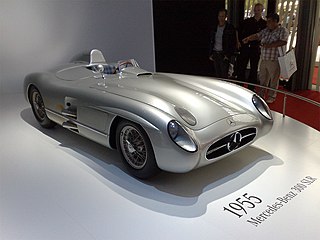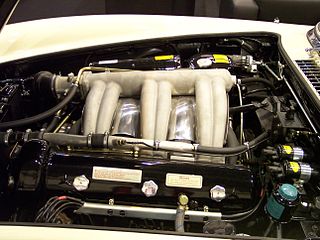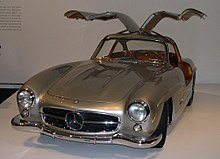
The Mercedes-Benz SLR McLaren is a grand tourer jointly developed by German automotive manufacturer Mercedes-Benz and British automobile manufacturer McLaren Automotive and sold from 2003 to 2010. When the car was developed, Mercedes-Benz owned 40 per cent of the McLaren Group and the car was produced in conjunction between the two companies. The "SLR" name is an abbreviation for "Sport Leicht Rennsport", and was a homage to the Mercedes-Benz 300 SLR which served as the car's inspiration. The car was offered in coupé, roadster and speedster bodystyles, with the latter being a limited edition model.

The Mercedes-Benz 300 SL is a two-seat sports car that was produced by Mercedes-Benz from 1954 to 1957 as a gullwinged coupé and from 1957 to 1963 as a roadster. The 300 SL traces its origins to the company's 1952 racing car, the W194, and was equipped with a mechanical direct fuel injection system that significantly increased the power output of its three-liter overhead camshaft straight-six engine.

The Mercedes-Benz SL-Class is a grand touring sports car manufactured by Mercedes-Benz since 1954. The designation SL derives from the German Sport-Leicht.

In the automotive industry, a gull-wing door, also known as a falcon-wing door or an up-door, is a car door that is hinged at the roof rather than the side, as pioneered by Mercedes-Benz 300 SL, first as a race car in 1952 (W194), and then as a production sports car in 1954.
John Cooper Fitch was an American racing driver and inventor. He was the first American to race automobiles successfully in Europe in the post-war era.

The Mercedes-Benz 300 SLR (W 196 S) is a two-seat sports racing car that took part in the 1955 World Sportscar Championship before a catastrophic crash and fire at Le Mans later that year ended its domination prematurely. The car was designated "SL-R", which was later condensed to "SLR". Technically, the W 196 S is based on the W 196 R, but has a slightly different engine, displacing 3 litres.

The Mercedes-Benz W189 model 300 was a four-door luxury tourer produced by Mercedes-Benz between 1957 and 1962. It was the company's flagship model at the time, equivalent to the modern S-Class and Maybach.

The Mercedes-Benz W188 was a two-door luxury sports tourer produced by Mercedes-Benz between 1951 and 1958. The company's most expensive and exclusive automobiles, the elegant, hand-built 300 S (1951-1954) and its successor 300 Sc (1955-1958) were the pinnacle of the Mercedes line of their era.

The Mercedes-Benz W186 Model 300 was a four-door luxury sedan produced by Mercedes-Benz between 1951 and 1957. It was the company's flagship model at the time, succeeding the World War II era W150. Three versions were produced in succession, known informally as the 300a, 300b, and 300c. An enlarged "300d" variant built on the W189 chassis succeeded it in late 1957.

The Mercedes-Benz W196 was a Formula One racing car produced by Mercedes-Benz for the 1954 and 1955 F1 seasons. Successor to the W194, in the hands of Juan Manuel Fangio and Stirling Moss it won 9 of 12 races entered and captured the only two world championships in which it competed.

The Mercedes-Benz 190 SL (W121) is a two-door luxury roadster produced by Mercedes-Benz between May 1955 and February 1963. Internally referred to as W121, it was first shown in prototype at the 1954 New York Auto Show, and was available with an optional removable hardtop.
The 1954 World Sportscar Championship season was the second season of FIA World Sportscar Championship motor racing. It featured a series of six endurance races for sportscars, contested from 24 January to 23 November 1954. The championship was won by Ferrari.
The 1955 World Sportscar Championship season was the third season of FIA World Sportscar Championship motor racing. It featured a series of six endurance races for sportscars, contested from 23 January to 16 October 1955.
The 1956 World Sportscar Championship was the fourth annual FIA World Sportscar Championship. It was a contested by sportscars over a series of five races from 29 January to 12 August 1956.
Throughout its long history, Mercedes-Benz has been involved in a range of successful motorsport activities, including sportscar racing, touring car racing, Grand Prix racing, and rallying. It is currently active in GT racing, and Formula One. Mercedes is also one of only three constructors to complete the Triple Crown of Motorsport, a feat that Mercedes achieved as both a chassis manufacturer and an engine manufacturer by winning the 1952 24 Hours of Le Mans.

Rudolf Uhlenhaut was a British-German engineer, driving engineer for Mercedes-Benz, and the father of Mercedes-Benz 300 SL and 300 SLR. He had a long association with the Mercedes-Benz racing programme of the 1930s and 1950s, and is best known for his road legal Uhlenhaut Coupé version of the 1955 Mercedes-Benz 300SLR race car.

The Mercedes-Benz SLS AMG is a front mid-engine, 2-seater, limited production grand tourer developed by the Mercedes-AMG division of German automotive manufacturer Mercedes-Benz, with the assistance of David Coulthard. The car is the successor to the Mercedes-Benz SLR McLaren and was described by Mercedes-Benz as a spiritual successor to the Mercedes-Benz 300SL Gullwing, mainly because it was inspired by the latter. SLS stands for "Super Leicht Sport".

The Ferrari 375 Plus is a sports racing car produced by Ferrari in 1954. The model competed internationally, winning many major races, including 24 Hours of Le Mans, Carrera Panamericana, 1000km of Buenos Aires, Agadir GP and Silverstone.

The Mercedes Benz M186 Engine was a 3.0–litre single overhead camshaft inline-6 developed in the early 1950s to power the company's new flagship 300 "Adenauer" (W186) four-door saloon. It made its debut at the Frankfurt Motor Show in April 1951.
The M194 is a straight-six engine produced by Daimler-Benz in limited numbers for its 1952 W194 300SL racer.
















